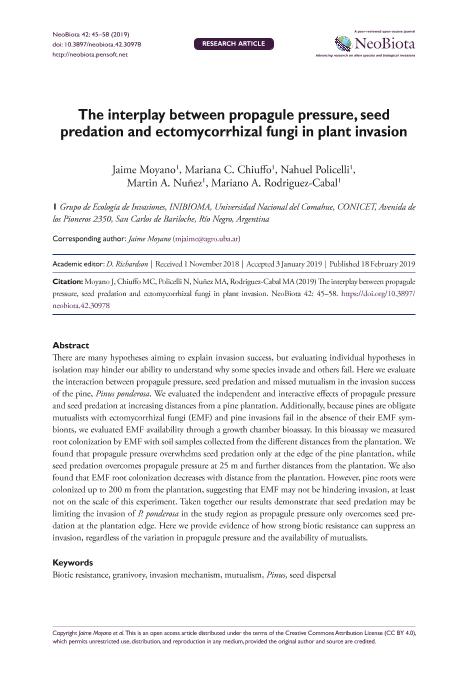Mostrar el registro sencillo del ítem
dc.contributor.author
Moyano, Jaime

dc.contributor.author
Chiuffo, Mariana Cecilia

dc.contributor.author
Policelli, Nahuel

dc.contributor.author
Nuñez, Martin Andres

dc.contributor.author
Rodriguez Cabal, Mariano Alberto

dc.date.available
2020-11-26T13:08:51Z
dc.date.issued
2019-02
dc.identifier.citation
Moyano, Jaime; Chiuffo, Mariana Cecilia; Policelli, Nahuel; Nuñez, Martin Andres; Rodriguez Cabal, Mariano Alberto; The interplay between propagule pressure, seed predation and ectomycorrhizal fungi in plant invasion; Pensoft Publishers; NeoBiota; 42; 2-2019; 45-58
dc.identifier.issn
1619-0033
dc.identifier.uri
http://hdl.handle.net/11336/119048
dc.description.abstract
There are many hypotheses aiming to explain invasion success, but evaluating individual hypotheses in isolation may hinder our ability to understand why some species invade and others fail. Here we evaluate the interaction between propagule pressure, seed predation and missed mutualism in the invasion success of the pine, Pinus ponderosa. We evaluated the independent and interactive effects of propagule pressure and seed predation at increasing distances from a pine plantation. Additionally, because pines are obligate mutualists with ectomycorrhizal fungi (EMF) and pine invasions fail in the absence of their EMF symbionts, we evaluated EMF availability through a growth chamber bioassay. In this bioassay we measured root colonization by EMF with soil samples collected from the different distances from the plantation. We found that propagule pressure overwhelms seed predation only at the edge of the pine plantation, while seed predation overcomes propagule pressure at 25 m and further distances from the plantation. We also found that EMF root colonization decreases with distance from the plantation. However, pine roots were colonized up to 200 m from the plantation, suggesting that EMF may not be hindering invasion, at least not on the scale of this experiment. Taken together our results demonstrate that seed predation may be limiting the invasion of P. ponderosa in the study region as propagule pressure only overcomes seed predation at the plantation edge. Here we provide evidence of how strong biotic resistance can suppress an invasion, regardless of the variation in propagule pressure and the availability of mutualists.
dc.format
application/pdf
dc.language.iso
eng
dc.publisher
Pensoft Publishers

dc.rights
info:eu-repo/semantics/openAccess
dc.rights.uri
https://creativecommons.org/licenses/by/2.5/ar/
dc.subject
BIOTIC RESISTANCE
dc.subject
GRANIVORY
dc.subject
INVASION MECHANISM
dc.subject
MUTUALISM
dc.subject
PINUS
dc.subject
SEED DISPERSAL
dc.subject.classification
Ecología

dc.subject.classification
Ciencias Biológicas

dc.subject.classification
CIENCIAS NATURALES Y EXACTAS

dc.title
The interplay between propagule pressure, seed predation and ectomycorrhizal fungi in plant invasion
dc.type
info:eu-repo/semantics/article
dc.type
info:ar-repo/semantics/artículo
dc.type
info:eu-repo/semantics/publishedVersion
dc.date.updated
2020-11-18T20:47:58Z
dc.journal.volume
42
dc.journal.pagination
45-58
dc.journal.pais
Bulgaria

dc.journal.ciudad
Sofia
dc.description.fil
Fil: Moyano, Jaime. Consejo Nacional de Investigaciones Científicas y Técnicas. Centro Científico Tecnológico Conicet - Patagonia Norte. Instituto de Investigaciones en Biodiversidad y Medioambiente. Universidad Nacional del Comahue. Centro Regional Universidad Bariloche. Instituto de Investigaciones en Biodiversidad y Medioambiente; Argentina
dc.description.fil
Fil: Chiuffo, Mariana Cecilia. Consejo Nacional de Investigaciones Científicas y Técnicas. Centro Científico Tecnológico Conicet - Patagonia Norte. Instituto de Investigaciones en Biodiversidad y Medioambiente. Universidad Nacional del Comahue. Centro Regional Universidad Bariloche. Instituto de Investigaciones en Biodiversidad y Medioambiente; Argentina
dc.description.fil
Fil: Policelli, Nahuel. Consejo Nacional de Investigaciones Científicas y Técnicas. Centro Científico Tecnológico Conicet - Patagonia Norte. Instituto de Investigaciones en Biodiversidad y Medioambiente. Universidad Nacional del Comahue. Centro Regional Universidad Bariloche. Instituto de Investigaciones en Biodiversidad y Medioambiente; Argentina
dc.description.fil
Fil: Nuñez, Martin Andres. Consejo Nacional de Investigaciones Científicas y Técnicas. Centro Científico Tecnológico Conicet - Patagonia Norte. Instituto de Investigaciones en Biodiversidad y Medioambiente. Universidad Nacional del Comahue. Centro Regional Universidad Bariloche. Instituto de Investigaciones en Biodiversidad y Medioambiente; Argentina
dc.description.fil
Fil: Rodriguez Cabal, Mariano Alberto. Consejo Nacional de Investigaciones Científicas y Técnicas. Centro Científico Tecnológico Conicet - Patagonia Norte. Instituto de Investigaciones en Biodiversidad y Medioambiente. Universidad Nacional del Comahue. Centro Regional Universidad Bariloche. Instituto de Investigaciones en Biodiversidad y Medioambiente; Argentina
dc.journal.title
NeoBiota
dc.relation.alternativeid
info:eu-repo/semantics/altIdentifier/url/https://neobiota.pensoft.net/article/30978/list/8/
Archivos asociados
